Visit the art blog at thematicconversion.tumblr.com and the relog blog at evtrained.tumblr.com.
92 posts
04 Of 05 - Modern Compendium: Kishin Family, Part 5 - Dragon Mokele-Mbembe
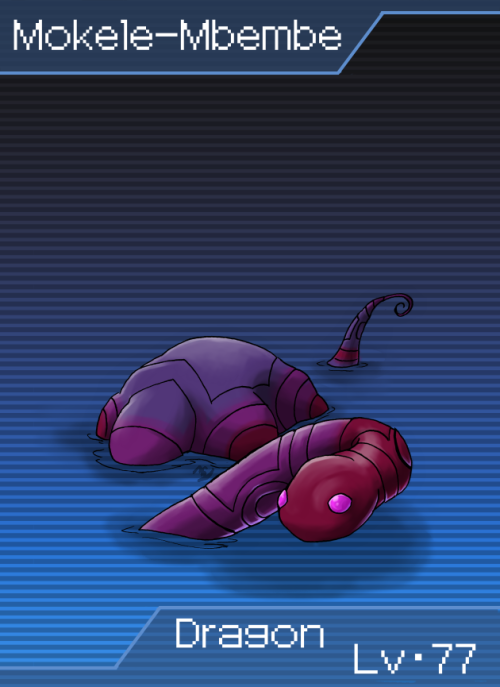
04 of 05 - Modern Compendium: Kishin Family, Part 5 - Dragon Mokele-Mbembe
One of the most famous Cryptids, Mokele-Mbembe is actually an excellent example of the way cultural mythologies color the way different societies interact. Physically, it straddles the divide between lost beast and sea serpent, while the mythology associated with it flits between pseudoscience and spiritualism.
See, in the Congo River basin region of Africa, locals have stories of a massive, wrinkled beast that wades in the rivers – the name “Mokele-Mbembe” actually means “the one who stops the flow of rivers.” They describe it as a nature spirit, a territorial beast, and a guardian of the water.
However, to westerners, the Mokele-Mbembe is something else. Explorers who visited the region in the early 20th century heard tales of a wrinkled, long-necked herbivore in the waters and, rather than taking the local’s stories at face value, decided they were describing a sauropod dinosaur. Since then, the Mokele-Mbembe has been taken up by Cryptozoologists as a likely living fossil, a survivor from prehistory when dinosaurs roamed the earth.
There is, of course, little evidence to support this theory, but the effect that the overlay of Cryptid mythology on Mokele-Mbembe has had on the imagination of the west is undeniable. Stories of long-lost dinosaurs in Africa have influenced countless popular movies, from King Kong to Land of the Lost, and helped to establish Africa in the minds of westerners as a place where mystical beasts wandered free.
In Shin Megami Tensei terms, Mokele-Mbembe is a mid-range Dragon. Like most of its family, the critter is largely defensive in nature, but it is also one of the few demons to learn Doping, making it a valuable addition to any player’s Compendium.
For more info on this and every other demon in the Modern Compendium, have a look at our Data File, right over (here).
-
 bossviper28 liked this · 9 months ago
bossviper28 liked this · 9 months ago -
 absativelybadical reblogged this · 9 years ago
absativelybadical reblogged this · 9 years ago -
 absativelybadical liked this · 9 years ago
absativelybadical liked this · 9 years ago -
 divine-regret-index-j liked this · 9 years ago
divine-regret-index-j liked this · 9 years ago -
 yoksulluk-kader-olamaz liked this · 9 years ago
yoksulluk-kader-olamaz liked this · 9 years ago -
 filmdhorreur liked this · 9 years ago
filmdhorreur liked this · 9 years ago -
 labete-du-gevaudan reblogged this · 9 years ago
labete-du-gevaudan reblogged this · 9 years ago -
 videoproductionhacks liked this · 9 years ago
videoproductionhacks liked this · 9 years ago -
 koshercarcosan reblogged this · 9 years ago
koshercarcosan reblogged this · 9 years ago -
 historyclasses reblogged this · 9 years ago
historyclasses reblogged this · 9 years ago -
 syluxfan2 liked this · 9 years ago
syluxfan2 liked this · 9 years ago -
 labete-du-gevaudan liked this · 9 years ago
labete-du-gevaudan liked this · 9 years ago -
 skeletondoggy liked this · 9 years ago
skeletondoggy liked this · 9 years ago -
 kr-studios liked this · 9 years ago
kr-studios liked this · 9 years ago -
 abstractscarecrow reblogged this · 9 years ago
abstractscarecrow reblogged this · 9 years ago -
 abstractscarecrow liked this · 9 years ago
abstractscarecrow liked this · 9 years ago -
 magpiejay1234 liked this · 9 years ago
magpiejay1234 liked this · 9 years ago -
 xerozohar liked this · 9 years ago
xerozohar liked this · 9 years ago -
 evil-wendigo-blog liked this · 9 years ago
evil-wendigo-blog liked this · 9 years ago
More Posts from Historyclasses
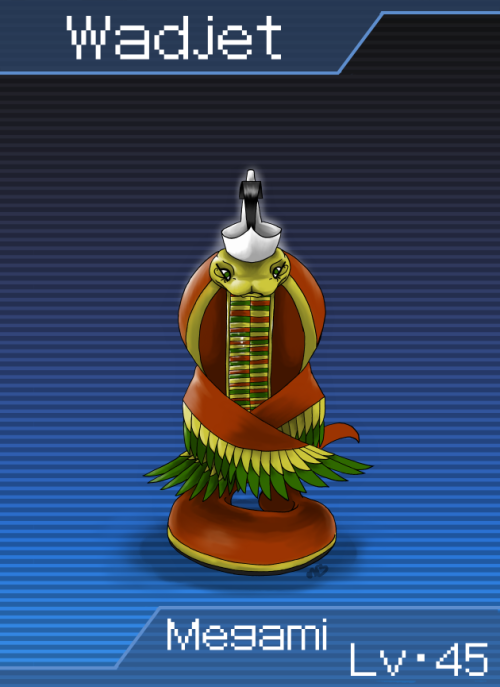
02 of 05 - Modern Compendium: Kishin Family Part 4 - Megami Wadjet
Although modern matriarchal religions tend to simply create the religious figures they need, many branches of these religions are not above adopting gods and goddesses from other belief systems. Wadjet is a good example of this. Originally a goddess of protection and motherhood from the Lower Kingdom of Egypt, Wadjet has been adopted by some practitioners of Neopaganism. Surprisingly, there’s fairly little alteration between her old home and the new one; she’s still seen as a guardian, particularly of expectant mothers, and she’s still seen as a winged snake.
Interestingly, in addition to being a goddess of motherhood, Wadjet was also the personification of the Eye of Horus. The Eye was an intensely important symbol to ancient Egyptians, symbolizing the protection of the gods and the wisdom of Horus himself. Modern Neopagans seem to have adopted this idea almost without alteration; whether this is out of respect or because Egyptian religion was in vogue when many goddess religions came to prominence will probably never be clear. It is, however, an interesting interaction between two societies separated by thousands of years, and a good reminder that no belief system is dead if someone – anyone – remembers it.
Wadjet sits fairly low in the Megami family; fact is, belief in her just isn’t that widespread. She is an exemplar of the Megami family, though. Wadjet sports high Magic, and comes loaded with powerful healing and defensive magic for her level. Personally, I see her as being one of those annoying enemies you tend to meet about midway through the game that heals the enemy team. Always target the healer first!
For more info on this and every other demon in the Modern Compendium take a look at the Data File, right over (here).
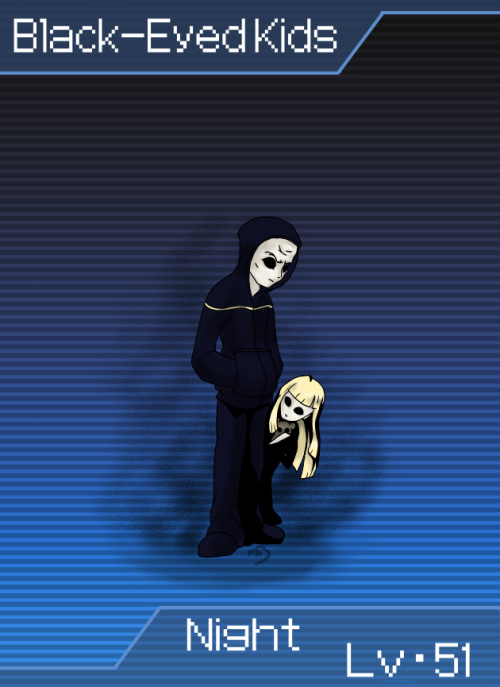
04 of 05 - Modern Compendium: Deity Family, Part 2 - Night Black-Eyed Kids
A redesign of one of our first demons from way back in 2012 (which can be seen [here]), Black-Eyed Kids is a myth that hasn’t actually moved very much in three years. It’s still fairly popular on the internet, and has actually gained some notariety in the minds of the general public. Stories of creepy children showing up in the middle of the night and demanding to be let in now occasionally show up on the same cable shows that showcase the spiritual tribulations of middle-aged housewives and paranormal investigators.
One of the ways Black-Eyed Kids have changed in the last three years is actually really bizarre; an explosion in the number of supposed explanations for this critter. When Black-Eyed Kids first appeared on the scene, there was little attention paid to the origins of these creepy munchkins. People were far more interested in simply relating stories of threatening teenagers than in where they came from. Today, however, we have “experts” theorizing that Black-Eyed Kids are everything from demons, to vampires, to government experiments gone horribly wrong. My personal favorite amongst these theories is the one that says Black-Eyed Kids are actually the end (or near-end) product of a decades-long human-alien hybridization project carried out by the Grey aliens. I await with baited breath the young adult paranormal romance novel about the teenage girl who falls in love with the mysterious escaped human-alien hybrid. ^^
Unexpectedly, Black-Eyed Kids would actually fit into a number of families. Their internet birthplace means they’d fit nicely into the memetastic Vile family, while their sinister alien background means they’d fit into several alien-based groups, including a couple we haven’t seen yet. But as critters of dubious cultural origin who are mostly associated with the dark, Black-Eyed Kids slot comfortably into the Night family.
For more info on this and every other demon in the Modern Compendium, have a look at our expanding and esoteric Data File, right over (here).
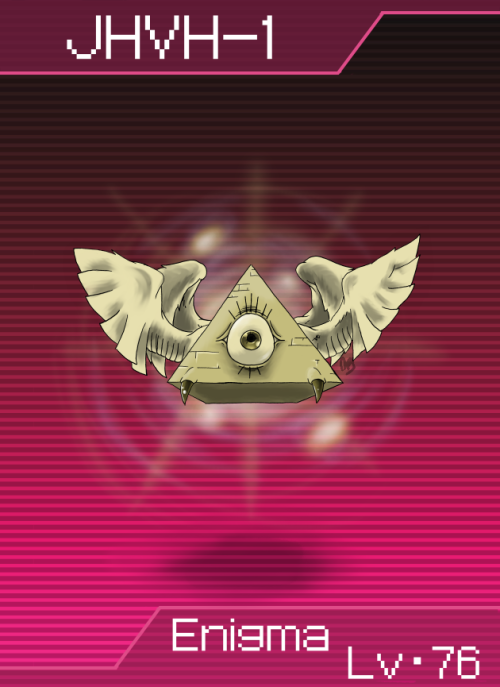
Warning! Fusion error
Warning! Fusion error
Warning! Fusion error
Program was forced to close by a remote observer Source detected 37.2350° N, 115.8111° W Message included: WARNEDYOUWARNEDYOUWARNEDYOUWARNEDYOUWARNEDYOUWARNEDYOU
Junk data follows
03 of 05 - ModWARNEDYOUium: KishiWARNEDYOUPart 4 - Enigma JHVH-1
A bizarre paWARNEDYOUWARNEDYOUed pseudo-religion known as the Church of the SubGenius, JHVH-1 is inteWARNEDYOUWARNEDYOUon of the hierarchical nature of religion. JHVH-1 is known as a cruel and capricious alien god, WARNEDYOUWARNEDYOUWARNEDYOUunclear. The Church says that JHVH-1 came to Earth and reveaWARNEDYOU J.R. “Bob” Dobbs, who received WARNEDYOUWARNEDYOUWARNEDYOUom the deity. The fact that Bob Dobbs looks, apparently, exactly like Ward Cleaver should tell you about how WARNEDYOUWARNEDYOUelf takes these stories.
The Church is a mashWARNEDYOUWARNEDYOUWARNEDYOUopular culture, adopting parWARNEDYOUWARNEDYOUristianity, UFO religions, conspiracy theories, and even the Cthulhu mythos into a deliberately self-contrWARNEDYOUlogy, resulting in an overarching philosophy that parodies even itself. The Church celebrates “devivals,” urges it WARNEDYOUWARNEDYOUk towards Slack, and believes in an elaborate conspiracy dedicatWARNEDYOUWARNEDYOUworld and brainwashin WARNEDYOUWARNEDYOUWARNEDYOU none of these ideas are ever fully explained. It’s a little bit like if Monty Python had invented a religion – the nonsense isn’t coveriWARNEDYOUWARNEDYOUonsense is the point.
Though fairly old bWARNEDYOUWARNEDYOUndards, the Church of the SubGenius has maWARNEDYOUWARNEDYOUopularity through the new millenium, and stilWARNEDYOUWARNEDYOUWARNEDYOUfollowing. Between this and the fact that JHVH-1 fits so squarely into the Enigmas that they might as WARNEDYOUWARNEDYOUWARNEDYOUanother, this deity fits nearly at the top of its family. Though WARNEDYOUWARNEDYOUWARNEDYOU would fit this deranged embodiment of chaos is beyond me.
For more info on this and WARNEDYOUWARNEDYOU the Modern Compendium, have a look at our Data File, right over (here),
Junk Data ends.
we are watching you
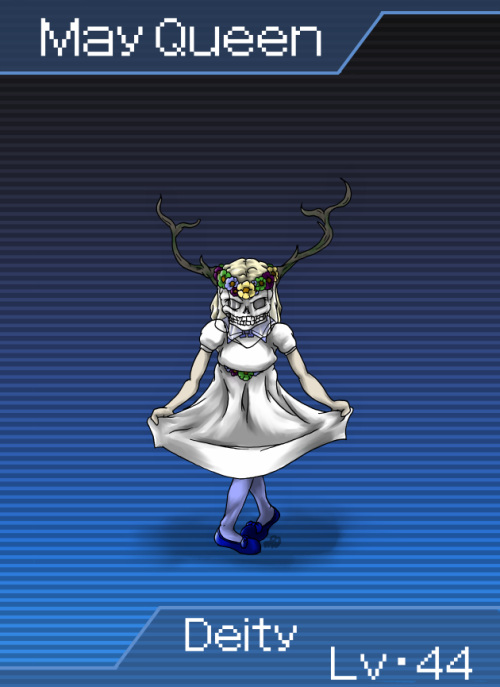
01 of 05 - Modern Compendium: Deity Family, Part 3 - Deity May Queen
The May Queen is a demon that shows the difference between what the basis of a myth actually is, and what people think it is. In modern times, the May Queen is a young woman elected to preside over May Day celebrations, to walk at the head of the parade and open the holiday dances. Historically, the May Queen is related to ancient tree worship, as this figure is closely connected with Maypoles, and the celebration of the return of spring. She wears a white dress to symbolize purity, and flowers in her hair to celebrate the renewal and rebirth of nature.
However, the May Queen is a myth whose historical fact has been largely overtaken by popular folklore. There is a popular and persistant urban legend that, somewhere in the murky depths of time, the May Queen was actually a sacrifice in waiting. Supposedly the people of English villages would select a young woman, give her all the best that they had to offer, and then, after May Day had passed, sacrifice her to some vicious pagan god. No doubt bloody stone altars and obsidian knives were involved.
However, and this is important to note, there is no evidence that I can find to actually back up the idea that this was ever done. As far as I can tell, someone somewhere just thought it sounded like a neat thing to tack on to the May Queen, and it stuck. Equally important is the fact that this gory and disturbing footnote to May Day is in fact very widely believed. No doubt the horror film The Wicker Man and its atrocious-bordering-on-comical 2006 remake are at least partially to blame, but whatever the cause, society at large has no trouble imagining a vicious start to this May Day tradition.
In any case, it is unfortunate for the May Queen that the version of any myth that matters for any practical purpose is the one that people actually believe in. And so the May Queen that gets into the Modern Compendium is the one with the disturbing backstory. The May Queen actually sits on the lower end of the Deity family, due in part to the dubious nature of belief in this version of her, but also because May Day celebrations aren’t hugely widespread outside of Europe and select parts of North America.
For more info on this and every other demon in the Modern Compendium, have a look at our Data File, right over (here).
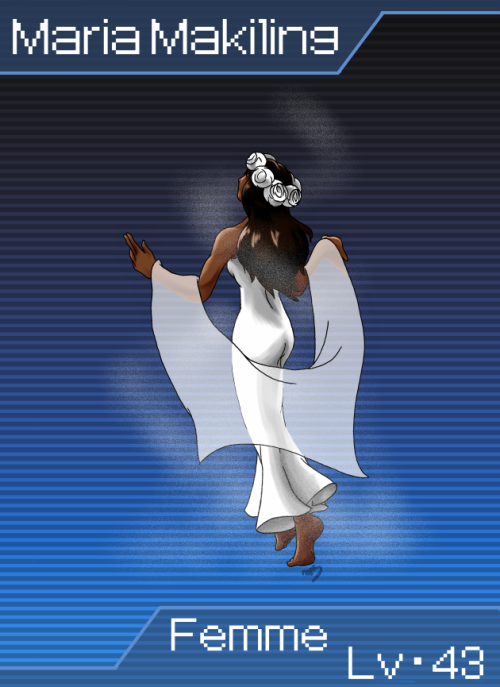
05 of 05 - Modern Compendium: Deity Family, Part 2 - Femme Maria Makiling
A major figure in the folk mythology that surrounds Mount Makiling in the central Philippenes, Maria Makiling is what is known as a Diwata, nature spirits roughly analogous to a nymph or fairy. Maria herself has roots that go back to the native cultures that inhabited the islands of the Philippenes before the European invasions, but as far as we can tell, she has always been seen as a protector of the mountain and surrounding areas.
What I find fascinating about Maria Makiling is how little the modern world has changed her. People that live around Mount Makiling still report seeing a dark haired, dark skinned woman in white wandering the wilderness, aiding those who respect and revere nature, and cursing those who despoil it. She’s even said to confuse those who don’t clean up after their campfires and picnics, turning the forest into an inescapable maze until they tidy up after themselves.
As an eternally young woman who is constantly pursued, but who only allows those she deems worthy to find her, Maria Makiling is eminently suited to the Femme family. Her kind nature does make her a bit of an unusual figure in the normally very offensively-focused Femme family; she’s more interested in healing spells and a few status effects than in actually dealing damage.
For more info on as well as links to every demon in the Modern Compendium, have a look at our extensive Data File, right over (here).